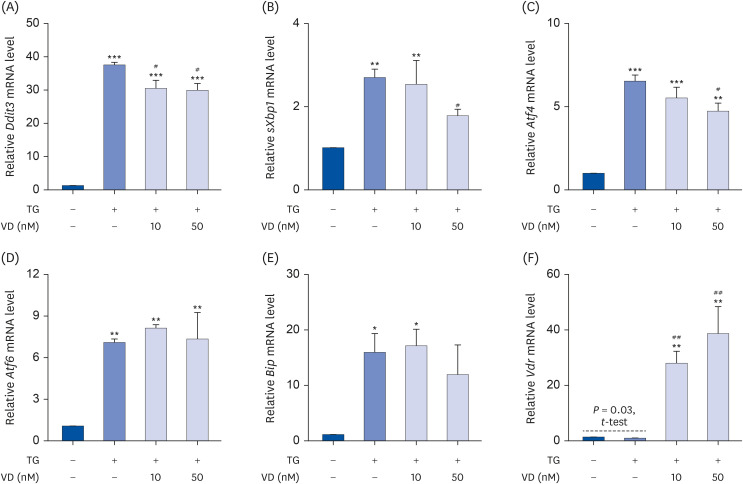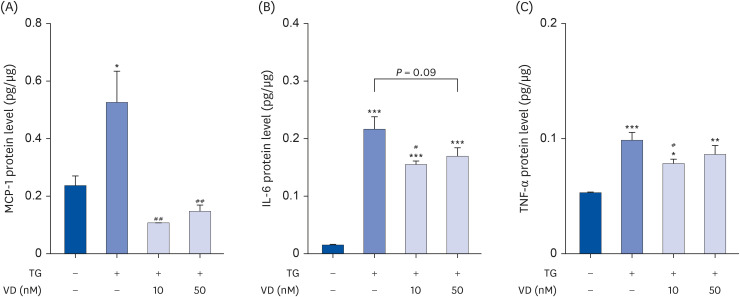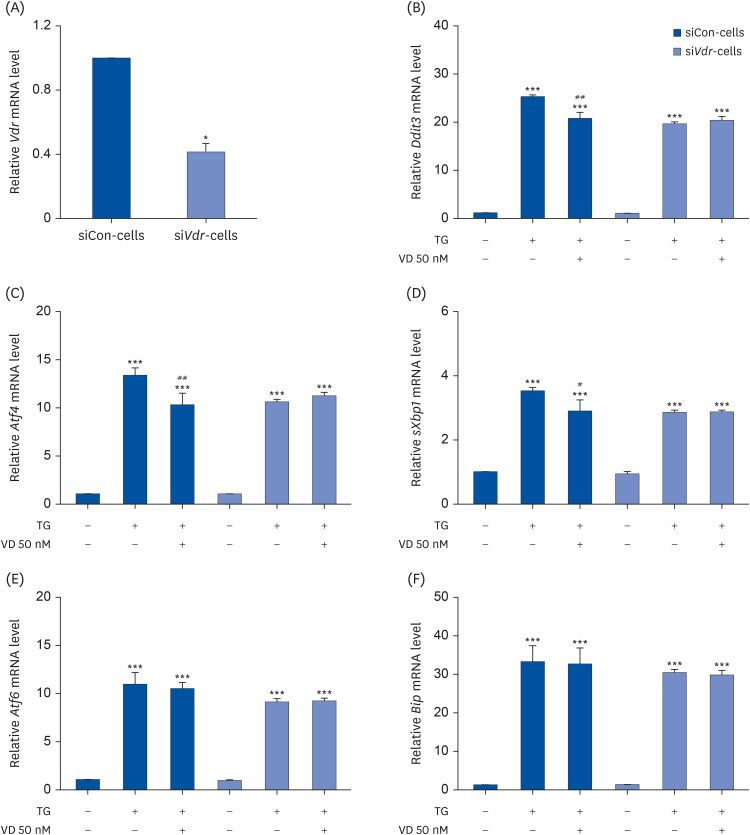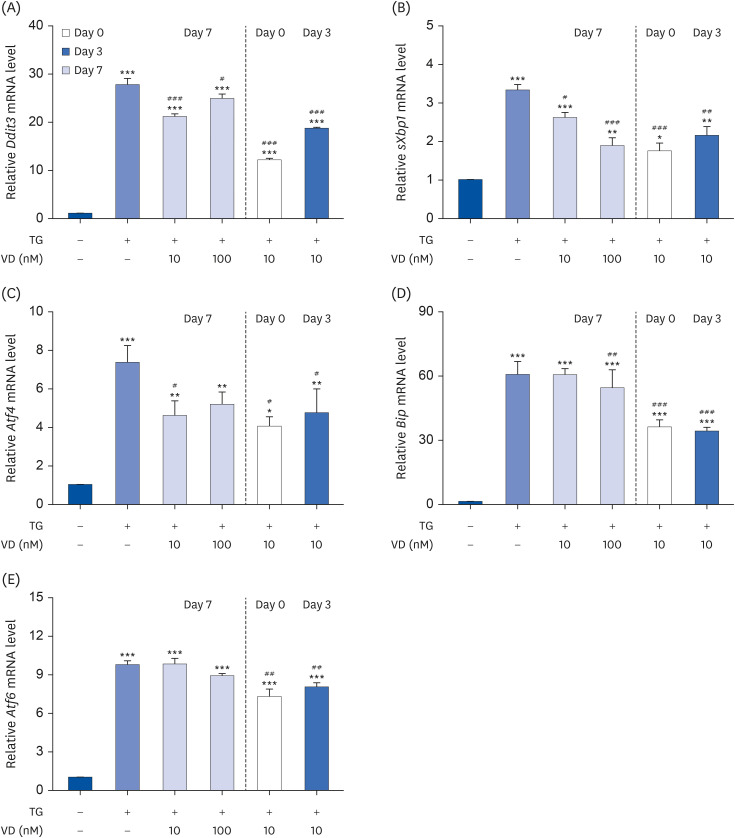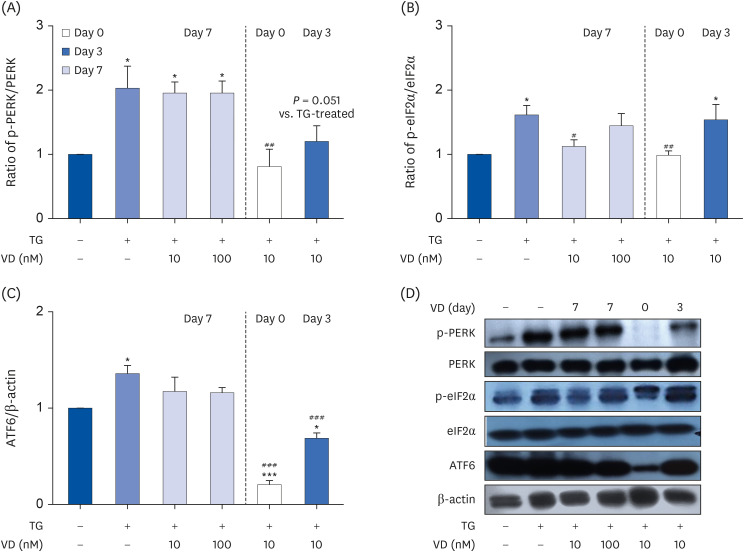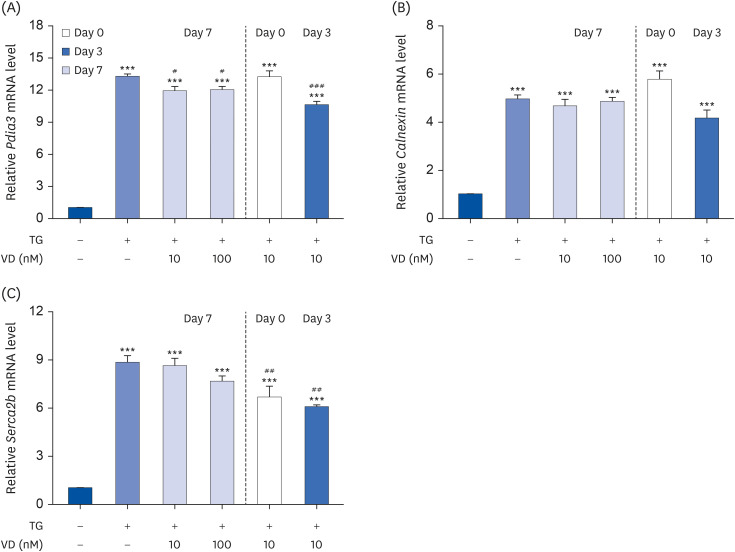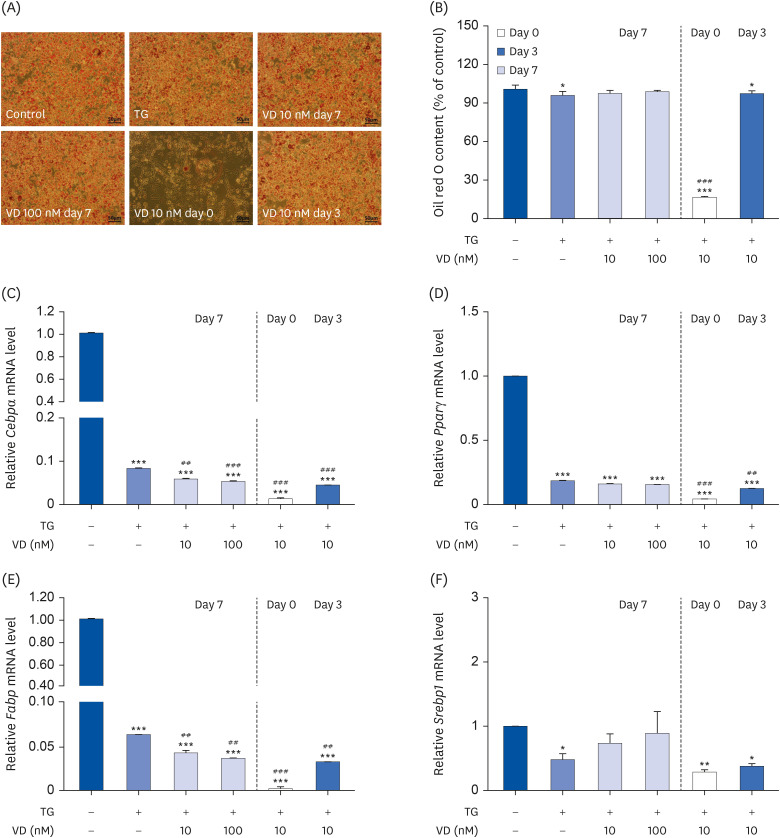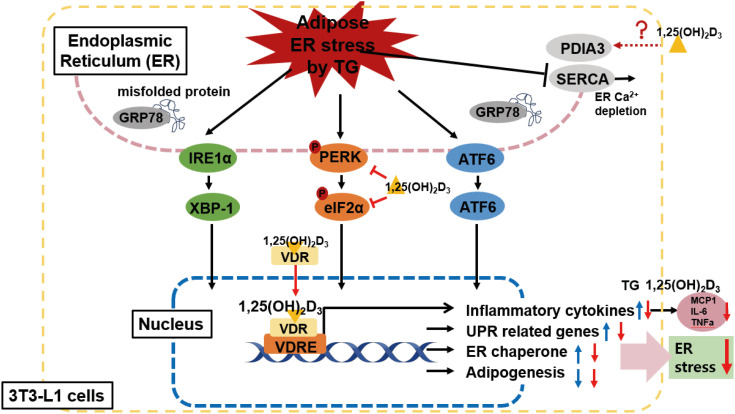Nutr Res Pract.
2024 Feb;18(1):1-18. 10.4162/nrp.2024.18.1.1.
1,25-dihydroxyvitamin D 3 affects thapsigargin-induced endoplasmic reticulum stress in 3T3-L1 adipocytes
- Affiliations
-
- 1Department of Food & Nutrition, College of Health Science, The University of Suwon, Hwaseong 18323, Korea
- KMID: 2552274
- DOI: http://doi.org/10.4162/nrp.2024.18.1.1
Abstract
- BACKGROUND/OBJECTIVES
Endoplasmic reticulum (ER) stress in adipose tissue causes an inflammatory response and leads to metabolic diseases. However, the association between vitamin D and adipose ER stress remains poorly understood. In this study, we investigated whether 1,25-dihydroxyvitamin D 3 (1,25(OH) 2 D 3 ) alleviates ER stress in adipocytes.
MATERIALS/METHODS
3T3-L1 cells were treated with different concentrations (i.e., 10–100 nM) of 1,25(OH)2 D 3 after or during differentiation (i.e., on day 0–7, 3–7, or 7). They were then incubated with thapsigargin (TG, 500 nM) for an additional 24 h to induce ER stress. Next, we measured the mRNA and protein levels of genes involved in unfold protein response (UPR) and adipogenesis using real-time polymerase chain reaction and western blotting and quantified the secreted protein levels of pro-inflammatory cytokines. Finally, the mRNA levels of UPR pathway genes were measured in adipocytes transfected with siRNA-targeting Vdr.
RESULTS
Treatment with 1,25(OH) 2 D 3 during various stages of adipocyte differentiation significantly inhibited ER stress induced by TG. In fully differentiated 3T3-L1 adipocytes, 1,25(OH) 2 D 3 treatment suppressed mRNA levels of Ddit3, sXbp1, and Atf4 and decreased the secretion of monocyte chemoattractant protein-1, interleukin-6, and tumor necrosis factor-α. However, downregulation of the mRNA levels of Ddit3, sXbp1, and Atf4 following 1,25(OH) 2 D 3 administration was not observed in Vdr-knockdown adipocytes. In addition, exposure of 3T3-L1 preadipocytes to 1,25(OH) 2 D 3 inhibited transcription of Ddit3, sXbp1, Atf4, Bip, and Atf6 and reduced the p-alpha subunit of translation initiation factor 2 (eIF2α)/eIF2α and p-protein kinase RNA-like ER kinase (PERK)/PERK protein ratios. Furthermore, 1,25(OH) 2 D 3 treatment before adipocyte differentiation reduced adipogenesis and the mRNA levels of adipogenic genes.
CONCLUSIONS
Our data suggest that 1,25(OH) 2 D 3 prevents TG-induced ER stress and inflammatory responses in mature adipocytes by downregulating UPR signaling via binding with Vdr. In addition, the inhibition of adipogenesis by vitamin D may contribute to the reduction of ER stress in adipocytes.
Keyword
Figure
Reference
-
1. Ouchi N, Parker JL, Lugus JJ, Walsh K. Adipokines in inflammation and metabolic disease. Nat Rev Immunol. 2011; 11:85–97. PMID: 21252989.2. Choe SS, Huh JY, Hwang IJ, Kim JI, Kim JB. Adipose tissue remodeling: its role in energy metabolism and metabolic disorders. Front Endocrinol (Lausanne). 2016; 7:30. PMID: 27148161.3. Bogdanovic E, Kraus N, Patsouris D, Diao L, Wang V, Abdullahi A, Jeschke MG. Endoplasmic reticulum stress in adipose tissue augments lipolysis. J Cell Mol Med. 2015; 19:82–91. PMID: 25381905.4. Cnop M, Foufelle F, Velloso LA. Endoplasmic reticulum stress, obesity and diabetes. Trends Mol Med. 2012; 18:59–68. PMID: 21889406.5. Ghemrawi R, Battaglia-Hsu SF, Arnold C. Endoplasmic reticulum stress in metabolic disorders. Cells. 2018; 7:63. PMID: 29921793.6. Olzmann JA, Carvalho P. Dynamics and functions of lipid droplets. Nat Rev Mol Cell Biol. 2019; 20:137–155. PMID: 30523332.7. Flamment M, Hajduch E, Ferré P, Foufelle F. New insights into ER stress-induced insulin resistance. Trends Endocrinol Metab. 2012; 23:381–390. PMID: 22770719.8. Kawasaki N, Asada R, Saito A, Kanemoto S, Imaizumi K. Obesity-induced endoplasmic reticulum stress causes chronic inflammation in adipose tissue. Sci Rep. 2012; 2:799. PMID: 23150771.9. Ozcan U, Cao Q, Yilmaz E, Lee AH, Iwakoshi NN, Ozdelen E, Tuncman G, Görgün C, Glimcher LH, Hotamisligil GS. Endoplasmic reticulum stress links obesity, insulin action, and type 2 diabetes. Science. 2004; 306:457–461. PMID: 15486293.10. Liang L, Chen J, Zhan L, Lu X, Sun X, Sui H, Zheng L, Xiang H, Zhang F. Endoplasmic reticulum stress impairs insulin receptor signaling in the brains of obese rats. PLoS One. 2015; 10:e0126384. PMID: 25978724.11. Jiao P, Ma J, Feng B, Zhang H, Diehl JA, Chin YE, Yan W, Xu H. FFA-induced adipocyte inflammation and insulin resistance: involvement of ER stress and IKKβ pathways. Obesity (Silver Spring). 2011; 19:483–491. PMID: 20829802.12. Longo M, Spinelli R, D’Esposito V, Zatterale F, Fiory F, Nigro C, Raciti GA, Miele C, Formisano P, Beguinot F, et al. Pathologic endoplasmic reticulum stress induced by glucotoxic insults inhibits adipocyte differentiation and induces an inflammatory phenotype. Biochim Biophys Acta. 2016; 1863:1146–1156. PMID: 26940722.13. Basseri S, Lhoták S, Sharma AM, Austin RC. The chemical chaperone 4-phenylbutyrate inhibits adipogenesis by modulating the unfolded protein response. J Lipid Res. 2009; 50:2486–2501. PMID: 19461119.14. Wood RJ. Vitamin D and adipogenesis: new molecular insights. Nutr Rev. 2008; 66:40–46. PMID: 18254883.15. Abbas MA. Physiological functions of vitamin D in adipose tissue. J Steroid Biochem Mol Biol. 2017; 165:369–381. PMID: 27520301.16. Wamberg L, Christiansen T, Paulsen SK, Fisker S, Rask P, Rejnmark L, Richelsen B, Pedersen SB. Expression of vitamin D-metabolizing enzymes in human adipose tissue -- the effect of obesity and diet-induced weight loss. Int J Obes (Lond). 2013; 37:651–657. PMID: 22828938.17. Park CY, Han SN. The role of vitamin D in adipose tissue biology: adipocyte differentiation, energy metabolism, and inflammation. J Lipid Atheroscler. 2021; 10:130–144. PMID: 34095008.18. Marcotorchino J, Gouranton E, Romier B, Tourniaire F, Astier J, Malezet C, Amiot MJ, Landrier JF. Vitamin D reduces the inflammatory response and restores glucose uptake in adipocytes. Mol Nutr Food Res. 2012; 56:1771–1782. PMID: 23065818.19. Sun X, Zemel MB. Calcitriol and calcium regulate cytokine production and adipocyte-macrophage cross-talk. J Nutr Biochem. 2008; 19:392–399. PMID: 17869082.20. Sun X, Zemel MB. Calcium and 1,25-dihydroxyvitamin D3 regulation of adipokine expression. Obesity (Silver Spring). 2007; 15:340–348. PMID: 17299106.21. Karkeni E, Marcotorchino J, Tourniaire F, Astier J, Peiretti F, Darmon P, Landrier JF. Vitamin D limits chemokine expression in adipocytes and macrophage migration in vitro and in male mice. Endocrinology. 2015; 156:1782–1793. PMID: 25730105.22. Cheng S, Massaro JM, Fox CS, Larson MG, Keyes MJ, McCabe EL, Robins SJ, O’Donnell CJ, Hoffmann U, Jacques PF, et al. Adiposity, cardiometabolic risk, and vitamin D status: the Framingham Heart Study. Diabetes. 2010; 59:242–248. PMID: 19833894.23. Mai XM, Chen Y, Camargo CA Jr, Langhammer A. Cross-sectional and prospective cohort study of serum 25-hydroxyvitamin D level and obesity in adults: the HUNT study. Am J Epidemiol. 2012; 175:1029–1036. PMID: 22312120.24. Pereira-Santos M, Costa PR, Assis AM, Santos CA, Santos DB. Obesity and vitamin D deficiency: a systematic review and meta-analysis. Obes Rev. 2015; 16:341–349. PMID: 25688659.25. Roth CL, Elfers CT, Figlewicz DP, Melhorn SJ, Morton GJ, Hoofnagle A, Yeh MM, Nelson JE, Kowdley KV. Vitamin D deficiency in obese rats exacerbates nonalcoholic fatty liver disease and increases hepatic resistin and Toll-like receptor activation. Hepatology. 2012; 55:1103–1111. PMID: 21994008.26. Mezza T, Muscogiuri G, Sorice GP, Prioletta A, Salomone E, Pontecorvi A, Giaccari A. Vitamin D deficiency: a new risk factor for type 2 diabetes? Ann Nutr Metab. 2012; 61:337–348. PMID: 23208163.27. Wen G, Eder K, Ringseis R. 1,25-hydroxyvitamin D3 decreases endoplasmic reticulum stress-induced inflammatory response in mammary epithelial cells. PLoS One. 2020; 15:e0228945. PMID: 32040528.28. Riek AE, Oh J, Sprague JE, Timpson A, de las Fuentes L, Bernal-Mizrachi L, Schechtman KB, Bernal-Mizrachi C. Vitamin D suppression of endoplasmic reticulum stress promotes an antiatherogenic monocyte/macrophage phenotype in type 2 diabetic patients. J Biol Chem. 2012; 287:38482–38494. PMID: 23012375.29. Rayalam S, Della-Fera MA, Ambati S, Yang JY, Park HJ, Baile CA. Enhanced effects of 1,25(OH)(2)D(3) plus genistein on adipogenesis and apoptosis in 3T3-L1 adipocytes. Obesity (Silver Spring). 2008; 16:539–546. PMID: 18239559.30. Chang E, Kim Y. Vitamin D decreases adipocyte lipid storage and increases NAD-SIRT1 pathway in 3T3-L1 adipocytes. Nutrition. 2016; 32:702–708. PMID: 26899162.31. Żmijewski MA. Nongenomic activities of vitamin D. Nutrients. 2022; 14:5104. PMID: 36501134.32. Dai N, Groenendyk J, Michalak M. Binding proteins | Ca2+ binding/buffering proteins: ER luminal proteins. Jez J, editor. Encyclopedia of Biological Chemistry III. Third Edition. Oxford: Elsevier;2021. p. 534–546.33. Sha H, He Y, Chen H, Wang C, Zenno A, Shi H, Yang X, Zhang X, Qi L. The IRE1alpha-XBP1 pathway of the unfolded protein response is required for adipogenesis. Cell Metab. 2009; 9:556–564. PMID: 19490910.34. Kamiya T, Hara H, Adachi T. Effect of endoplasmic reticulum (ER) stress inducer thapsigargin on the expression of extracellular-superoxide dismutase in mouse 3T3-L1 adipocytes. J Clin Biochem Nutr. 2013; 52:101–105. PMID: 23525536.35. Han J, Murthy R, Wood B, Song B, Wang S, Sun B, Malhi H, Kaufman RJ. ER stress signalling through eIF2α and CHOP, but not IRE1α, attenuates adipogenesis in mice. Diabetologia. 2013; 56:911–924. PMID: 23314846.36. Trump BF, Berezesky IK. The role of cytosolic Ca2+ in cell injury, necrosis and apoptosis. Curr Opin Cell Biol. 1992; 4:227–232. PMID: 1599689.37. Ntambi JM, Takova T. Role of Ca2+ in the early stages of murine adipocyte differentiation as evidenced by calcium mobilizing agents. Differentiation. 1996; 60:151–158. PMID: 8766594.38. Deng J, Liu S, Zou L, Xu C, Geng B, Xu G. Lipolysis response to endoplasmic reticulum stress in adipose cells. J Biol Chem. 2012; 287:6240–6249. PMID: 22223650.39. Bettaieb A, Matsuo K, Matsuo I, Wang S, Melhem R, Koromilas AE, Haj FG. Protein tyrosine phosphatase 1B deficiency potentiates PERK/eIF2α signaling in brown adipocytes. PLoS One. 2012; 7:e34412. PMID: 22509299.40. Park CY, Kim D, Seo MK, Kim J, Choe H, Kim JH, Hong JP, Lee YJ, Heo Y, Kim HJ, et al. Dysregulation of lipid droplet protein expression in adipose tissues and association with metabolic risk factors in adult females with obesity and type 2 diabetes. J Nutr. 2023; 153:691–702. PMID: 36931749.41. Lim J, Park HS, Kim J, Jang YJ, Kim JH, Lee Y, Heo Y. Depot-specific UCP1 expression in human white adipose tissue and its association with obesity-related markers. Int J Obes. 2020; 44:697–706.42. Hu X, Hu C, Liu J, Wu Z, Duan T, Cao Z. 1,25-(OH)2D3 protects pancreatic beta cells against H2O2-induced apoptosis through inhibiting the PERK-ATF4-CHOP pathway. Acta Biochim Biophys Sin (Shanghai). 2021; 53:46–53. PMID: 33242093.43. Haas MJ, Jafri M, Wehmeier KR, Onstead-Haas LM, Mooradian AD. Inhibition of endoplasmic reticulum stress and oxidative stress by vitamin D in endothelial cells. Free Radic Biol Med. 2016; 99:1–10. PMID: 27458123.44. Rozpędek-Kamińska W, Siwecka N, Wawrzynkiewicz A, Wojtczak R, Pytel D, Diehl JA, Majsterek I. The PERK-dependent molecular mechanisms as a novel therapeutic target for neurodegenerative diseases. Int J Mol Sci. 2020; 21:2108. PMID: 32204380.45. Wang X, Xu L, Gillette TG, Jiang X, Wang ZV. The unfolded protein response in ischemic heart disease. J Mol Cell Cardiol. 2018; 117:19–25. PMID: 29470977.46. Oyadomari S, Mori M. Roles of CHOP/GADD153 in endoplasmic reticulum stress. Cell Death Differ. 2004; 11:381–389. PMID: 14685163.47. Gregor MF, Hotamisligil GS. Thematic review series: adipocyte biology. Adipocyte stress: the endoplasmic reticulum and metabolic disease. J Lipid Res. 2007; 48:1905–1914. PMID: 17699733.48. Park CY, Kim TY, Yoo JS, Seo Y, Pae M, Han SN. Effects of 1,25-dihydroxyvitamin D3 on the inflammatory responses of stromal vascular cells and adipocytes from lean and obese mice. Nutrients. 2020; 12:364. PMID: 32019160.49. Ding C, Wilding JP, Bing C. 1,25-dihydroxyvitamin D3 protects against macrophage-induced activation of NFκB and MAPK signalling and chemokine release in human adipocytes. PLoS One. 2013; 8:e61707. PMID: 23637889.50. Zhang Y, Leung DY, Richers BN, Liu Y, Remigio LK, Riches DW, Goleva E. Vitamin D inhibits monocyte/macrophage proinflammatory cytokine production by targeting MAPK phosphatase-1. J Immunol. 2012; 188:2127–2135. PMID: 22301548.51. Antoniotti V, Bellone S, Gonçalves Correia FP, Peri C, Tini S, Ricotti R, Mancioppi V, Gagliardi M, Spadaccini D, Caputo M, et al. Calreticulin and PDIA3, two markers of endoplasmic reticulum stress, are associated with metabolic alterations and insulin resistance in pediatric obesity: a pilot study. Front Endocrinol (Lausanne). 2022; 13:1003919. PMID: 36213269.52. Farmer SR. Transcriptional control of adipocyte formation. Cell Metab. 2006; 4:263–273. PMID: 17011499.53. Kong J, Li YC. Molecular mechanism of 1,25-dihydroxyvitamin D3 inhibition of adipogenesis in 3T3-L1 cells. Am J Physiol Endocrinol Metab. 2006; 290:E916–E924. PMID: 16368784.54. Lee H, Bae S, Yoon Y. Anti-adipogenic effects of 1,25-dihydroxyvitamin D3 are mediated by the maintenance of the wingless-type MMTV integration site/β-catenin pathway. Int J Mol Med. 2012; 30:1219–1224. PMID: 22922938.55. Ji S, Doumit ME, Hill RA. Regulation of adipogenesis and key adipogenic gene expression by 1, 25-dihydroxyvitamin D in 3T3-L1 cells. PLoS One. 2015; 10:e0126142. PMID: 26030589.56. Turishcheva E, Vildanova M, Onishchenko G, Smirnova E. The role of endoplasmic reticulum stress in differentiation of cells of mesenchymal origin. Biochemistry (Mosc). 2022; 87:916–931. PMID: 36180988.57. Li Y, Camacho P. Ca2+-dependent redox modulation of SERCA 2b by ERp57. J Cell Biol. 2004; 164:35–46. PMID: 14699087.
- Full Text Links
- Actions
-
Cited
- CITED
-
- Close
- Share
- Similar articles
-
- Endoplasmic Reticulum Stress and Diabetes
- Sequestration of sorcin by aberrant forms of tau results in the defective calcium homeostasis
- Activation of AMP-Activated Protein Kinase Attenuates Tumor Necrosis Factor-alpha-Induced Lipolysis via Protection of Perilipin in 3T3-L1 Adipocytes
- Mitochondrial dysfunction and activation of iNOS are responsible for the palmitate-induced decrease in adiponectin synthesis in 3T3L1 adipocytes
- The Effect of Tribbles-Related Protein 3 on ER Stress-Suppressed Insulin Gene Expression in INS-1 Cells

